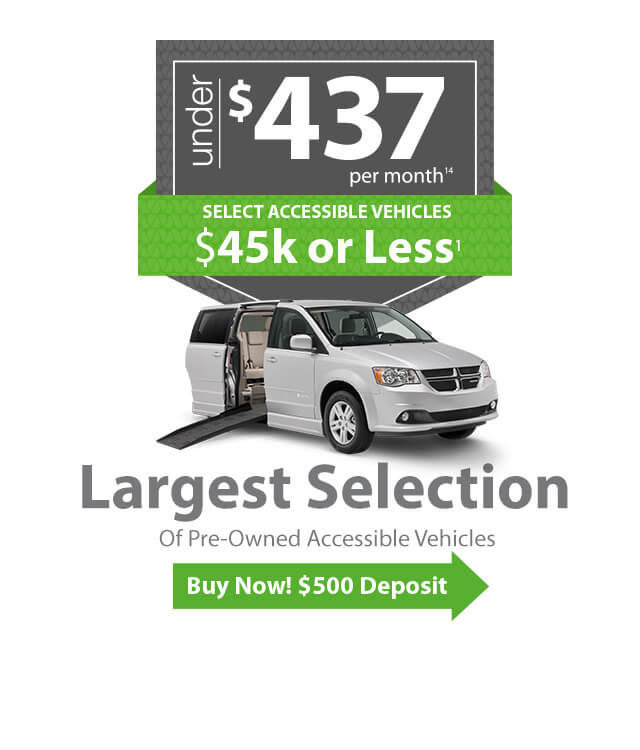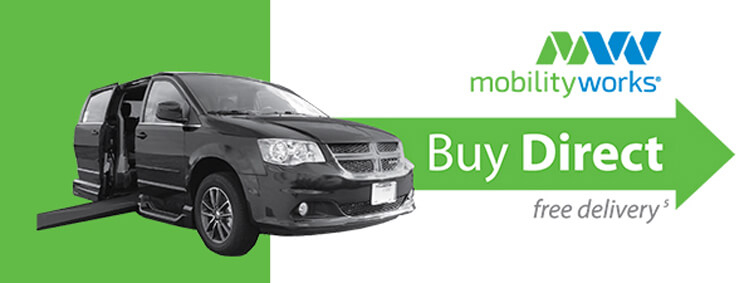
Automated Fold-Out Ramp
Minivan conversions with fold-out ramps can be either automated or manually deployed. Most van conversions utilize some type of automated or “automatic” system with a push button or key-fob to operate an electric motor that is used to fold down and fold up the ramp.
Certified Mobility Consultants
Most quality providers will have consulting staff on hand in their stores to work with clients in helping to explain different mobility options and with selecting the right van or equipment. Certified Mobility Consultants (also known as CMCs) have gone through specific training with the various mobility equipment manufacturers in order to properly demonstrate the use of the products. CMCs also have general knowledge in disability issues and will explore the client’s physical capabilities in order to make the right vehicle conversion or mobility equipment recommendation.
Conversion Manufacturers
Major auto manufacturers such as Chrysler/Dodge, Toyota, Ford and Honda build new van chassis from the ground up. These are often referred to as original equipment manufacturers or OEMs. A conversion manufacturer takes new OEM vehicles or pre-owned vans with low mileage and “converts” them for wheelchair accessibility for mobility dealers. A conversion can include lowering the floor, adding a kneeling system and ramp, new removable front seating, securement L-track on the floor, and electrical system upgrades for safe and convenient operation of the vehicle. Lowering the floor in itself presents many engineering challenges that require considerable time in the conversion process. Two of the most popular conversion manufacturers are BraunAbility and Vantage Mobility International (also known as VMI). Note: MobilityWorks is BraunAbility’s and VMI’s largest dealer in the United States.
Docking Systems
Wheelchair docking is an alternative system for securing the wheelchair to the floor of a van. Docking systems use an automated clamp like device mounted to the floor that locks on to a pin that is added to the frame of the wheelchair. Docking systems utilize an electronic push-button control console for quickly locking and releasing the wheelchair. Many wheelchair drivers utilize a docking system, eliminating the need for tie-down straps that would be problematic to use in the driver position.
Hand Controls
Hand controls are commonly used by paraplegic and amputee drivers and can be installed on most any type of vehicle. Several different styles of hand controls are available to match the needs of the driver with the automobile, van, truck or SUV. Most hand controls are mechanical, which means they are connected to the accelerator and braking system with the use of connecting rods and various hand grip options. The most popular among the systems is a push-pull design. The drive pushes forward to accelerate and pulls down on the controls to brake. A Certified Mobility Consultant can demonstrate the various options and connect the client with a Certified Driver Rehabilitation Specialist (CDRS) for driver evaluation and on-road training. For public safety and liability reasons, certification is required before a mobility dealer can order and install hand controls on a vehicle.
In-Floor Ramp
Mobility vans that have a side-entry ramp can also be equipped with an in-floor ramp system. What this means is that the ramp is located under the floor of the vehicle (when not in use) and slides out when deployed. The advantage of an in-floor system is that the ramp is completely out of the way, unlike a fold-out ramp that is an obstruction in the door opening in the up position. In-floor ramps can be a little more expensive in that they require more work to install, but can be a very practical option for those who want to utilize the passenger side sliding door without the wheelchair ramp being deployed.
Kneeling System
Ramp angle is a critical part of the making a van accessible. The lower the angle the easier is to enter the vehicle, particularly for those in manual chairs who wheel themselves in without an attendant. Kneeling systems are designed to raise the opposite side of the van, with an automated actuator, which lowers the passenger side, reducing the height of the floor and ramp. Kneeling systems are completely hidden and out of view from passengers and are controlled with the same push-button operation as the the ramp. In most cases, the van’s electrical system has been designed to open the sliding door, kneel the van and deploy the ramp in sequential order in one easy step.
L-Track
In order to secure the wheelchair to the floor of the van with a tie-down system, a strip of metal “L-Track” is attached to the floor. L-Track has small half-inch circular openings along the entire length that allow for a tie-down strap to be positioned in the correct angle and position for the person in the chair. L-Track can be installed in horizontal or vertical configurations depending on the type of van and desired wheelchair position.
Lowered Floor
Since headroom above the wheelchair passenger can be tight and a lower ramp angle is desired, most wheelchair vans are modified with a lowered floor. This accomplishes both goals of providing more room and a reduced angle necessary for entering and exiting the vehicle. Height at the door opening can also be a critical dimension for a larger person sitting upright in a chair or for a caregiver assisting with loading and securement. Lowered floor vans are structurally modified and require significant re-engineering of many vehicle components such as the muffler system, gas tank, and brake lines. Because of these modifications, conversion manufacturers have to crash test their vehicles to meet federal safety standards. It’s important that people try a vehicle’s lowered floor, kneeling and ramp system before buying.
New-New and New-Used Vans
A New-New conversion would be a brand new wheelchair accessible conversion on a brand new vehicle (less than a few hundred miles), while a New-Used would be new adaptive equipment conversion being applied to a pre-owned vehicle. Typically this would only take place on a van with lower mileage (less than 20,000) and being only a few years old.



